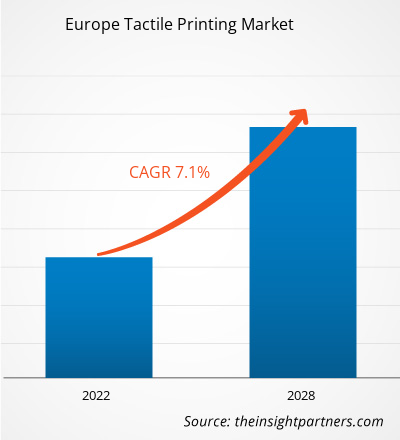The tactile printing market in Europe is expected to grow from US$ 342.11 million in 2021 to US$ 553.67 million by 2028; it is estimated to grow at a CAGR of 7.1% from 2021 to 2028.
France, Germany, Italy, UK, and Russia are major economies in Europe. Industries demanding for innovative packaging is the major factor driving the Europe tactile printing market. Tactile printing in packaging takes on many forms. For instance, the material can take the form of a rubber-like surface that makes the handing of hard-to-open and heavy containers easy during transport. This kind of packaging can draw the attention of customers and allow makers to thin the sidewalls without sacrificing top load strength. Tactile printed labels and packaging can also assist visually impaired people to ensure they are using the right product. These are underused elements meant for multiple senses to appeal customers with visual cues as well as with patterns that tempt the fingertips. To reach the masses, brands now-a-days are tapping into the personalization of packaging by leveraging technological advancements. The tactile printing technology is giving rise to high-end packaging designs for products from consumer goods categories, including food, beverage, beer & wine, medical, and beauty. In addition, it is being deployed to produce specialized labels for automotive products, including exterior, interior, and safety and security labels. In the chemicals industry, tactile warning symbols and Braille can be combined to generate custom printed labels for countries with requirements; for example, many EU countries require all toxic, harmful, and flammable products to carry a warning triangle. More recently, manufacturers of product categories such as pet foods, baby foods, dairy, fabric care, health care, and savory spreads are trying to explore the advantages of soft-touch packaging.
Germany, Spain, the UK, Italy, and France are among the notably affected European countries by the COVID-19 pandemic. Businesses are suffering from financial crises as they either had to suspend their operations or reduce their activities substantially in the initial stages of the pandemic. Europe has one of the world’s robust food &beverages industries. Hence, business lockdowns and travel bans led to the slowdown of the growth of this sector in 2020, and the impact is likely to continue to some extent in 2021. Moreover, disruptions in supply chain in the region led to imbalance in the demand and supply of products in 2020. Various countries in Europe, such as Italy, Spain, France, the UK, and Germany, have implemented drastic measures and travel restrictions to limit the spread of SARS-CoV-2.According to the EU legislation, Braille text and tactile labeling are mandatory on pharmaceutical products. However, suspension of business activities has affected product launches and new investments in various European countries, thus impacting the growth of the tactile printing market. In addition, disruptions in raw materials and equipment supply chain further worsen the conditions for tactile printing solution manufacturers in this region. As per a survey by the British Plastics Federation (BPF), ~80% of the surveyed packaging companies from the UK are expecting a drop in turnover, while ~90% of them have anticipated issues in supply chain.
With the new features and technologies, vendors can attract new customers and expand their footprints in emerging markets. This factor is likely to drive the Europe tactile printing market. The Europe tactile printing market is expected to grow at a good CAGR during the forecast period.
- This FREE sample will include data analysis, ranging from market trends to estimates and forecasts.
Europe Tactile printing Market Segmentation
Europe Tactile printing Market – By Application
- Packaging & Labels
- Tactile graphics
- Secure Documentation
Europe Tactile printing Market – By End User
- Braille Users
- Industrial
- Government & Defense
Europe Tactile printing Market, by Country
- France
- Germany
- Italy
- Russia
- UK
- Rest of Europe
Europe Tactile printing Market - Companies Mentioned
- Altix
- American Thermoform
- Canon Inc
- Index Braille
- Kanematsu USA
- Konica Minolta, Inc.
- Roland DG Corporation
- Sturdy Print & Design Ltd
- ViewPlus Technologies Inc
Europe Tactile Printing Report Scope
| Report Attribute | Details |
|---|---|
| Market size in 2021 | US$ 342.11 Million |
| Market Size by 2028 | US$ 553.67 Million |
| Global CAGR (2021 - 2028) | 7.1% |
| Historical Data | 2019-2020 |
| Forecast period | 2022-2028 |
| Segments Covered |
By Application
|
| Regions and Countries Covered | Europe
|
| Market leaders and key company profiles |
- Historical Analysis (2 Years), Base Year, Forecast (7 Years) with CAGR
- PEST and SWOT Analysis
- Market Size Value / Volume - Global, Regional, Country
- Industry and Competitive Landscape
- Excel Dataset


- Vision Guided Robotics Software Market
- Digital Pathology Market
- MEMS Foundry Market
- Nuclear Decommissioning Services Market
- E-Bike Market
- Saudi Arabia Drywall Panels Market
- Artificial Intelligence in Defense Market
- Space Situational Awareness (SSA) Market
- Cosmetic Bioactive Ingredients Market
- Molecular Diagnostics Market

Report Coverage
Revenue forecast, Company Analysis, Industry landscape, Growth factors, and Trends

Segment Covered
Application and End User

Regional Scope
North America, Europe, Asia Pacific, Middle East & Africa, South & Central America

Country Scope
UK, Germany, France, Italy, Russia
Trends and growth analysis reports related to Electronics and Semiconductor : READ MORE..
- Altix
- American Thermoform
- Canon Inc
- Index Braille
- Kanematsu USA
- Konica Minolta, Inc.
- Roland DG Corporation
- Sturdy Print & Design Ltd
- ViewPlus Technologies Inc

 Get Free Sample For
Get Free Sample For